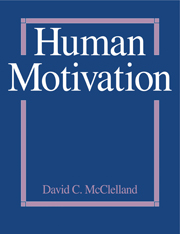Book contents
- Frontmatter
- Preface
- Foreword
- Contents
- Part 1 Background
- 1 Conscious and Unconscious Motives
- 2 Motives in the Personality Tradition
- 3 Motivation in the Behaviorist Tradition
- Part 2 The Nature of Human Motives
- Part 3 Important Motive Systems
- Part 4 Contextual Effects on Human Motives
- Bibliography
- Acknowledgments
- Index
1 - Conscious and Unconscious Motives
Published online by Cambridge University Press: 05 July 2014
- Frontmatter
- Preface
- Foreword
- Contents
- Part 1 Background
- 1 Conscious and Unconscious Motives
- 2 Motives in the Personality Tradition
- 3 Motivation in the Behaviorist Tradition
- Part 2 The Nature of Human Motives
- Part 3 Important Motive Systems
- Part 4 Contextual Effects on Human Motives
- Bibliography
- Acknowledgments
- Index
Summary
• MOTIVES AS ONE OF THREE MAJOR DETERMINANTS OF BEHAVIOR
What is the subject matter of motivation? From the commonsense point of view, motivation refers on one hand to conscious intents, to such inner thoughts as, I wish I could play the piano, I want to be a doctor, and I am trying hard to solve this problem. On the other hand, looking at behaviors from the outside, motivation refers to inferences about conscious intents that we make from observing behaviors. Thus, if we see a young girl perform a connected series of acts such as walking into a room, drawing up the piano stool, getting out some music, opening the piano, and starting to play, we infer that she wants to play the piano. If she stops playing after a while, we infer that she no longer wants to play the piano. As Marshall Jones (1955) put it in introducing the annual volumes of the Nebraska Symposium on Motivation, the subject matter of motivation has to do with “how behavior gets started, is energized, is sustained, is directed, is stopped.” Put another way, motivation has to do with the why of behavior, as contrasted with the how or the what of behavior. We can observe what the girl is doing, that is, playing the piano. Or we can observe how she is doing it, that is, what motor skills she is using to play the piano. Or we can try to determine why she is doing what she is doing.
Information
- Type
- Chapter
- Information
- Human Motivation , pp. 3 - 30Publisher: Cambridge University PressPrint publication year: 1988
